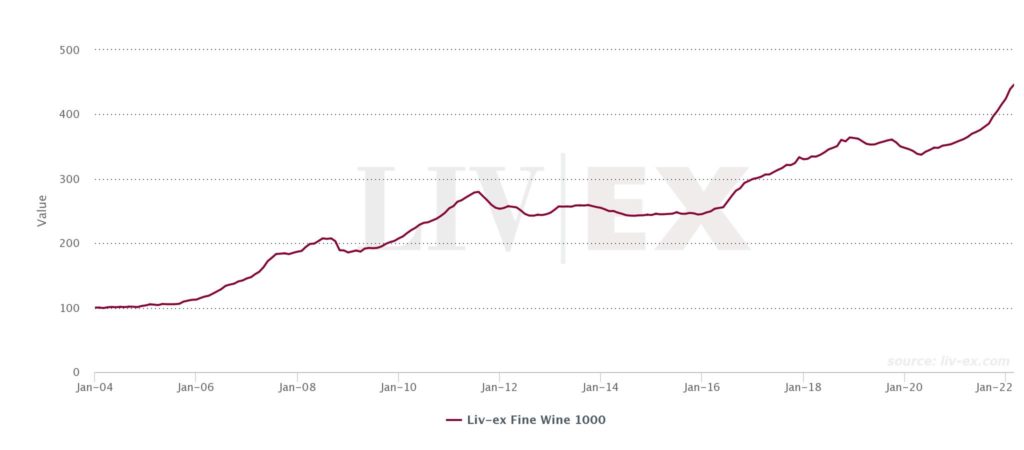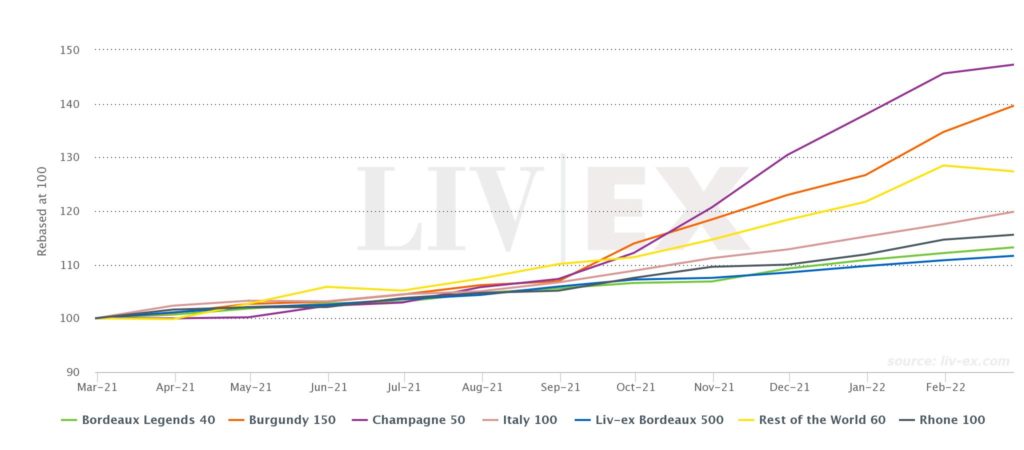- The Liv-ex 1000 rose 1.59% in February.
- The Burgundy 150 was the best-performing sub-index.
- Rises were not as strong as they were in January.

*made with the Liv-ex Charting Tool
The Liv-ex Fine Wine 1000, the broadest measure of the market, rose 1.59% in February, ending the month at a new high of 446.23.
The index out-performed the Liv-ex 100 which rose just 0.4% this month – its smallest gain since May 2020.
Burgundy and Italy lead gains
The Burgundy 150 and Italy 100 were the best-performing sub-indices last month. The Burgundy 150 rose 3.6% and Italy 100 2.0%. The Champagne 50 also rose 1.1%.
Several of these rises, however, were not as strong than their January performances, where Burgundy rose 6.4% and Champagne 5.6%.
White Burgundy labels including Bonneau du Martray’s Corton Charlemagne 2011 and Domaine Leflaive’s Batard Montrachet 2012 and 2014 were among the month’s best-performing labels.
Italy’s performance was likely boosted by the start of the new 2019 releases from Tuscany. Ornellaia’s stable was released through La Place de Bordeaux this week. Meanwhile, Sassicaia 2019 was released in mid-February for £1,990 per dozen. It sparked immediate interest among buyers and its current Market Price is £2,733.
Dom Pérignon’s Rosé 2006 was the top-performing Champagne.
Liv-ex 1000 sub-indices performance

*made with the Liv-ex Charting Tool
 About Liv-ex indices
About Liv-ex indices
The Liv-ex Fine Wine 1000 tracks 1,000 wines from across the world, arranged into seven sub-indices: the Bordeaux 500, the Bordeaux Legends 40, the Burgundy 150, the Champagne 50, the Rhone 100, the Italy 100 and the Rest of the World 60.
The index is calculated using the Liv-ex Mid Price, which refers to the mid-point between the highest live bid and lowest live offer on the market. The prices are validated against additional data including transaction prices and are the most robust measure for pricing wines available in the market.
The reason for this is because other sources of fine wine price information and indices base their calculations on list prices. These are advertised prices, often collected from sellers who may be advertising wine that they don’t have in stock. There is no firm commitment to buy or sell at an advertised price. The real value of the wine may be higher or lower than listed.
Liv-ex uniquely provides prices from real transactions among the wine trade. These are actual trade prices, as well as firm commitments to buy or sell on the market at a given point in time. All transactions are standardised by condition and tax status, allowing you to make like-for-like comparisons. Our members value this because it is real, proven price information.
Not a member of Liv-ex? Request a demo to see the exchange and a member of our team will be in touch with you shortly.





